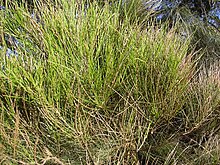Casuarina glauca
| Casaurina glauca | |
|---|---|
 |
|
| Scientific classification | |
| Kingdom: | Plantae |
| (unranked): | Angiosperms |
| (unranked): | Eudicots |
| (unranked): | Rosids |
| Order: | Fagales |
| Family: | Casuarinaceae |
| Genus: | Casuarina |
| Species: | C. glauca |
| Binomial name | |
|
Casuarina glauca Sieber |
|
Casuarina glauca, commonly known as the swamp she-oak, swamp oak, grey oak, or river oak, is a species of Casuarina native to the east coast of Australia. It is found from central Queensland south to southern New South Wales. It has become naturalised in the Everglades in Florida where it is considered a weed.
Franz Sieber described the swamp oak as Casuarina glauca in 1826. The species name is derived from the Latin glauca "glaucous".
The Kabi name for the plant, bilai, was used for the town and locality of Bli Bli, Queensland. The gadigal name is guman.
It is closely related to C. cunninghamiana. Hybrids with C. cunninghamiana subsp. cunninghamiana have been recorded where the two species co-occur, such as at Lower Portland and Wisemans Ferry.
The swamp oak grows as a 8–10 m high tree, or rarely to 20 m. It can be restricted to a stunted shrub around 2 m (7 ft) tall when exposed to the elements on clifftops. The greyish brown bark has scales and small fissures. The branches have numerous drooping branchlets that are up to 38 cm long, and composed of small cylindrical segments known as articles. These articles are 8 to 20 mm long and 0.9–1.2 mm wide. The leaves themselves are reduced to tiny 'teeth' that are 0.6 to 0.9 mm long. 12–17 (rarely 20) teeth arise from the nodes between articles on the branchlets. The oval cones are 9–18 mm long by 7–9 mm wide.
Casuarina glauca is found along Australia's east coast from Yeppoon in central Queensland to Bermagui in southern New South Wales. Some stands within the Royal Botanic Gardens in Sydney predate European settlement. Populations along the New South Wales coastline are at risk due to clearing of habitat for development. It has become highly invasive in Florida.
Casuarina glauca grows in or near brackish water along the banks of rivers and estuaries. Suckering from the roots, the swamp oak can form dense stands of trees. It grows on alluvial soils of sandstone or shale origin. The water table lies 30 cm or less under the surface.This tree then acts to turn shallows into land by preventing erosion and collecting material among its roots.
C. glauca is an actinorhizal plant producing root nitrogen-fixing nodules infested by Frankia. There is a regular pattern of cell layers containing flavans. Although not a legume, C. glauca, produces a hemoglobin (not a leghemoglobin) in its symbiotic root nodules.
...
Wikipedia
